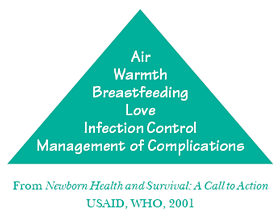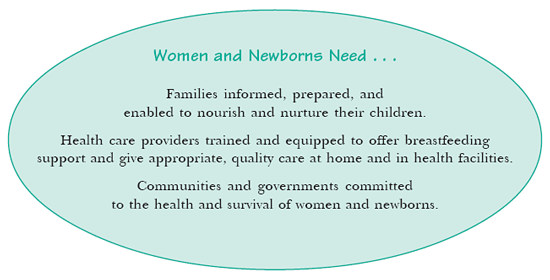 |
|
Birth, Initiation of Breastfeeding, and the First Seven Days after Birth
Facts for Feeding > Birth, Initiation of Breastfeeding, and the First Seven Days after Birth
The First Week: A Risky Time
Labor and Delivery
|
Ten Steps to Successful BreastfeedingEvery facility providing maternity services and care for newborns infants should:
From Protecting, Promoting and Supporting Breastfeeding: The Special Role of Maternity Services - A Joint UNICEF/WHO Statement, 1989 |
![]()
 The first few hours after delivery are a critical time for both mother and newborn. The mother is recovering from the sudden dramatic physical and
hormonal changes triggered by labor, birth, and the expulsion of the placenta. The drop in placental hormones “signals” her body to begin
making breastmilk in sufficient quantities to feed her baby. Those attending the mother at birth must keep a watchful eye to detect abnormal bleeding
and to ensure that her nutrition and fluid needs are met and her comfort is maintained.
The first few hours after delivery are a critical time for both mother and newborn. The mother is recovering from the sudden dramatic physical and
hormonal changes triggered by labor, birth, and the expulsion of the placenta. The drop in placental hormones “signals” her body to begin
making breastmilk in sufficient quantities to feed her baby. Those attending the mother at birth must keep a watchful eye to detect abnormal bleeding
and to ensure that her nutrition and fluid needs are met and her comfort is maintained.
At this same time, the newborn is undergoing the dramatic shift to life outside the womb. The immediate
care required by the baby includes attention to the initiation of breathing, skin-to-skin contact with the mother, warmth,
immediate and exclusive breastfeeding, and clean cord care.
For the healthy baby, the first routine after delivery should be skin-to-skin contact and initiation of breastfeeding. Other routines such as cord care, eye care, and weighing can follow. Bathing is not recommended until several hours after birth. Suctioning of the baby’s mouth and nose should not be routine but only done if necessary to clear secretions that are preventing the baby from breathing well. A baby who is crying does not need suctioning. If suctioning is necessary, it should be done gently so it does not injure the delicate tissue of the baby’s mouth and throat, which could interfere with breastfeeding.
The baby should be wiped from head to toe with a dry cloth and placed skin-to-skin against the mother. Baby and mother should then be
covered with another dry cloth. Immediate mother/newborn contact takes advantage of the newborn’s natural alertness following normal
vaginal birth and fosters bonding. This immediate contact also reduces maternal bleeding and stabilizes the baby’s temperature,
respiratory rate, and blood sugar level. Even a mother who requires stitches in the birth canal can have the baby placed against her skin.
Healthy newborns delivered vaginally are awake and alert, with inborn rooting and sucking reflexes to help them find the breast and nipple,
latch on, and start the first feed. Most newborns are ready to find the nipple and latch onto the breast within the first hour of birth.
Left alone on the mother’s stomach, a healthy newborn scoots upwards pushing with the feet, pulling with the arms, and bobbing the head until
finding and latching on the nipple. A newborn’s sense of smell is highly developed, which also helps in finding the nipple. As the baby
moves to the nipple, the mother produces high levels of oxytocin, which helps contract the uterine muscle and keep the uterus firm, thereby
minimizing her bleeding. Oxytocin also causes her breasts to release colostrum when the baby finds the nipple.
The health care provider or labor companion can help position the baby, so latch-on is effective and does not hurt the mother. Pillows or a
folded blanket under the mother’s head may help. Or the mother can roll to one side and tuck the baby next to her.
A baby born by Cesarean Section can benefit from skin-to-skin contact by being
held close to the mother’s cheek right after delivery. In this situation, when
initiation of breastfeeding takes place—if possible within the first two hours
after surgery—a knowledgeable health care provider will need to help the mother
with positioning and attachment to ensure her comfort. For low birth weight and
healthy preterm babies, kangaroo care is an effective way of caring for them.
Kangaroo care is defined as “early prolonged, continuous skin-to-skin care in a
kangaroo position between the mother and the newborn.” Kangaroo care has been
shown to achieve effective and prolonged body temperature regulation and stable
heart and respiratory rates in the low birth weight newborn. Skin-to-skin care
encourages latch-on and suckling, mother-baby bonding, and establishment of
successful breastfeeding once a baby is mature enough to suck.
Colostrum—the sticky, yellow-white early milk—should be the newborn’s first taste. There should be no prelacteal feeds such as water, other liquids, or ritual foods. Because of its high levels of antibodies, vitamin A, and other protective factors, colostrum is often called the baby’s first immunization.
The risk of vitamin A deficiency is higher for infants whose mothers are vitamin A deficient. A single high-dose (200,000 IU) vitamin A capsule will help build up the mother’s vitamin A stores, increase the vitamin A content of breastmilk, and reduce the risk of infection in the mother and her baby.
Mother and baby should be kept together. During the first few hours after delivery, the mother’s temperature, pulse, blood pressure—often called vital signs—and bleeding can be checked while the baby remains on her abdomen. The baby’s temperature, breathing, and heart rate can also be checked this way.

![]()
 During the first days mothers want to know how often to feed the baby, whether breastfeeding is
going well, and if the baby is getting enough milk. Women who have had a history
of feeding problems can be encouraged to try new behaviors to prevent the same
problems. Reassurance from health care providers and support from family is
particularly important at this time.
During the first days mothers want to know how often to feed the baby, whether breastfeeding is
going well, and if the baby is getting enough milk. Women who have had a history
of feeding problems can be encouraged to try new behaviors to prevent the same
problems. Reassurance from health care providers and support from family is
particularly important at this time.
The newborn should be observed for correct positioning and attachment. The baby should be held close to the mother, facing the breast with the baby’s ear, shoulder, and hip in a straight line. Signs of correct latch-on include wide-opened mouth with the nipple and much of the areola (the dark area around the nipple) in the mouth, lips rolled outward, and tongue over the lower gum. Visible jaw movement drawing milk out and rhythmical suckling with an audible swallow should be evident.
Under special circumstances, initiation may be delayed because mother and infant are separated for medical reasons. Also, premature babies may initially have difficulty suckling at the breast. Health care providers should provide additional assistance and support so that nearly every mother will, in time, be able to breastfeed her baby.
Teaching the mother to effectively express colostrum and to feed it to her baby will enable her to give the baby the nutrient-rich and protective first milk, establish the milk supply, and help avoid engorgement when the milk “comes in.” For a mother recovering from a difficult or surgical delivery, it is very important that she not have to contend with the added difficulties of overly full breasts.
If a baby cannot suckle at the breast, an excellent way to give expressed breastmilk is with a small cup. Cup feeding may be needed for low birth weight and premature infants and for those separated from their mother for other reasons. Cups are easier than feeding bottles to keep clean. The feeding behavior the baby learns with ‘lapping’ the milk from the edge of the cup does not interfere with latch-on when the baby is ready to feed at the breast. Artificial nipples do not conform to a baby’s mouth the same way as a mother’s nipple. A baby can rapidly become accustomed to a way of sucking from an artificial nipple which, when applied to the mother, can cause her pain and be less effective in removing the breastmilk.
A mother and her family need to be reassured that colostrum meets all of the baby’s nutrient and fluid requirements. The more the baby suckles, the sooner mature breastmilk is produced.
![]()
As a guideline, newborns should breastfeed at least 8–12 times in 24 hours. The length of the feed will vary from feed to feed and from baby to baby. Unrestricted (on-demand breastfeeding day and night) stimulates milk production and helps prevent engorgement. Infant formula, animal milk, herbal teas, water, or any other type of liquid or food may introduce dangerous contaminants, interfere with mother’s milk production, and begin a cycle where less frequent breastfeeding leads to less breastmilk production. Mothers should be encouraged to feed on the first breast without time restriction before offering the second breast to ensure that the baby gets the rich fat content in the hind milk.
During the first days after childbirth, women are recovering from profound physical and hormonal changes. They may at times be discouraged and experience discomfort, anxiety, and exhaustion. Mothers and their families should know that these feelings are common among mothers during the first week or two after birth. They should not worry if a mother has a low-grade fever (not above 37.6 C or 100 F) on the day her milk comes in. This fever should last no more than 24 hours. They should also know that the sharp contractions of the uterus that a mother may experience during or after breastfeeding for the first several days— particularly if she has given birth before—are normal and will soon disappear.
Birth is a life-giving and life-changing experience. Mothers need emotional support, good nutrition, and rest during this profound period in their lives. Their self-confidence increases knowing that they are providing their baby with the very best nourishment, comfort, and care.
Mothers should know how to contact health care providers in the community who support exclusive breastfeeding for the first six months and
who know how to advise mothers that experience breastfeeding difficulties such
as sore, cracked nipples or engorged breasts. Mothers should also know how to
contact breastfeeding support groups and lay counselors.
![]()
 About the third or fourth day, most mothers notice that their milk becomes more plentiful.The body is beginning to transition to the
production of mature breastmilk—a process that can take about two weeks.
About the third or fourth day, most mothers notice that their milk becomes more plentiful.The body is beginning to transition to the
production of mature breastmilk—a process that can take about two weeks.
During this period of transition, special attention is needed to prevent normal breast fullness from turning into painful engorgement or even infection. If the breasts are very full, the health care provider can help the mother hand express some of the first milk to soften the nipple and the area around the nipple so that the baby can attach well to the breast. Exclusive, frequent breastfeeding will help to prevent and to treat engorgement.
Mothers should be alert to signs of illness and report anything unusual to a health care provider. They should know how to tell if the baby is getting enough breastmilk: baby passes urine at least six times in 24 hours, mother can hear the sound of the baby swallowing, and mother’s breasts feel softer after a feed. During days 4–7, the baby should pass at least four stools in 24 hours. From weeks 2–6, the baby should pass at least one stool in 24 hours. After the sixth week, the average number of stools in infants varies widely.
Mother and baby are just beginning their partnership. At any time doubts, breastfeeding problems, and external factors such as the marketing of breastmilk substitutes can disrupt the routines being established. The health care provider and community health worker can help create a social climate supportive to breastfeeding women by promoting evidence-based practices within their organizations. They can advocate for policies that reinforce these practices, link community services with the health sector, and provide families with accurate information and quality care.

![]()
Cattaneo A et al. Kangaroo mother care in low-income countries. International Network in Kangaroo Mother Care. J Trop Pediatr 1998; 44 (5):279-82.
Chalmers B et al. WHO principles of perinatal care: The essential antenatal, perinatal, and postnatal care course. Birth 2001; 28 (3) 202–7.
Hofmeyr GJ et al. Companionship to modify the clinical birth environment: Effects on progress and perception of labour, and breastfeeding. Brit J of Obstet Gynecol 1991; 98:756-764.
Madi BC et al. Effects of female relative support in labor: A randomized controlled trial. Birth 1999; 26 (1):4-8.
Rajan L. The impact of obstetric procedures and analgesia/anesthesia during labour and delivery on breastfeeding. Midwifery 1994; 10:87-103.
WHO. Evidence for the ten steps to successful breastfeeding (WHO/CHD/98.9). Geneva: WHO, 1998.
Other references available upon request.
![]()
Facts for Feeding is a publication of LINKAGES: Breastfeeding, LAM, Related Complementary
Feeding, and Maternal Nutrition Program, and was made possible through support
provided to the Academy for Educational Development (AED) by the GH/ HIDN of the
United States Agency for International Development (USAID), under the terms of
Cooperative Agreement No. HRN-A-00-97-00007-00. Mary Kroeger provided technical
assistance for the development of this publication. The opinions expressed herein are those
of the author( s) and do not necessarily reflect the views of USAID or AED.
July 2003
| LINKAGES Academy for Educational Development 1825 Connecticut Avenue, NW, Washington, DC 20009 U.S. |
Phone (202) 884-8221 Fax (202) 884-8977 E-mail linkages@aed.org Website http://www.linkagesproject.org/ |